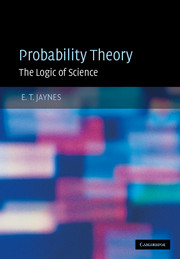Book contents
- Frontmatter
- Contents
- Editor's foreword
- Preface
- Part I Principles and elementary applications
- Part II Advanced applications
- 11 Discrete prior probabilities: the entropy principle
- 12 Ignorance priors and transformation groups
- 13 Decision theory, historical background
- 14 Simple applications of decision theory
- 15 Paradoxes of probability theory
- 16 Orthodox methods: historical background
- 17 Principles and pathology of orthodox statistics
- 18 The Ap distribution and rule of succession
- 19 Physical measurements
- 20 Model comparison
- 21 Outliers and robustness
- 22 Introduction to communication theory
- Appendix A Other approaches to probability theory
- Appendix B Mathematical formalities and style
- Appendix C Convolutions and cumulants
- References
- Bibliography
- Author index
- Subject index
19 - Physical measurements
from Part II - Advanced applications
Published online by Cambridge University Press: 05 September 2012
- Frontmatter
- Contents
- Editor's foreword
- Preface
- Part I Principles and elementary applications
- Part II Advanced applications
- 11 Discrete prior probabilities: the entropy principle
- 12 Ignorance priors and transformation groups
- 13 Decision theory, historical background
- 14 Simple applications of decision theory
- 15 Paradoxes of probability theory
- 16 Orthodox methods: historical background
- 17 Principles and pathology of orthodox statistics
- 18 The Ap distribution and rule of succession
- 19 Physical measurements
- 20 Model comparison
- 21 Outliers and robustness
- 22 Introduction to communication theory
- Appendix A Other approaches to probability theory
- Appendix B Mathematical formalities and style
- Appendix C Convolutions and cumulants
- References
- Bibliography
- Author index
- Subject index
Summary
We have seen, in Chapter 7, how the great mathematician Leonhard Euler was unable to solve the problem of estimating eight orbital parameters from 75 discrepant observations of the past positions of Jupiter and Saturn. Thinking in terms of deductive logic, he could not even conceive of the principles by which such a problem could be solved. But, 38 years later, Laplace, thinking in terms of probability theory as logic, was in possession of exactly the right principles to resolve the great inequality of Jupiter and Saturn. In this chapter we develop the solution as it would be done today by considering a simpler problem, estimating two parameters from three observations. But our general solution, in matrix notation, will include Laplace's automatically.
Reduction of equations of condition
Suppose we wish to determine the charge e and mass m of the electron. The Millikan oil-drop experiment measures e directly. The deflection of an electron beam in a known electromagnetic field measures the ratio e/m. The deflection of an electron toward a metal plate due to attraction of image charges measures e2/m.
From the results of any two of these experiments we can calculate values of e and m. But all the measurements are subject to error, and the values of e and m obtained from different experiments will not agree. Yet each of the measurements does contain some information relevant to our question that is not contained in the others.
Information
- Type
- Chapter
- Information
- Probability TheoryThe Logic of Science, pp. 589 - 600Publisher: Cambridge University PressPrint publication year: 2003
